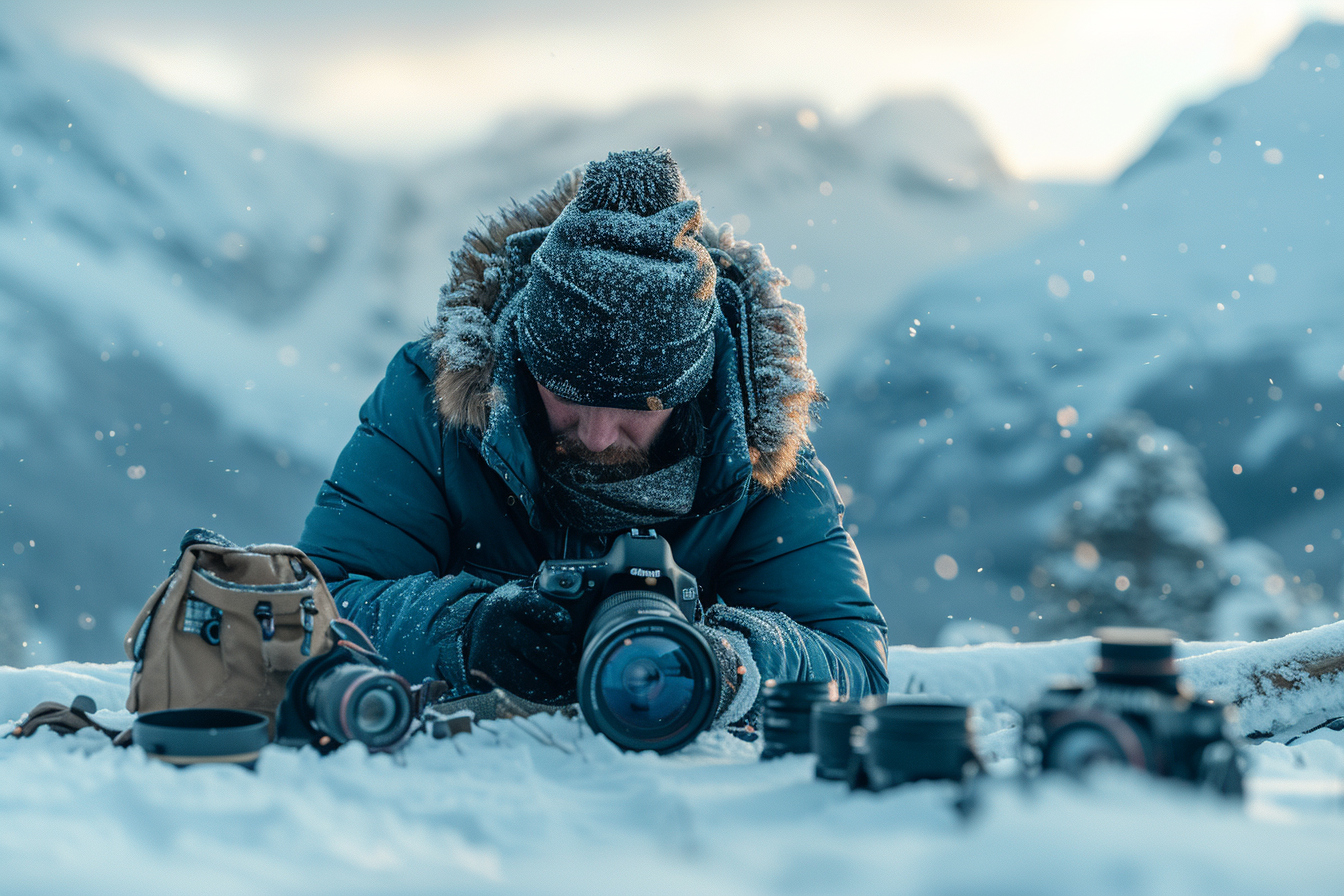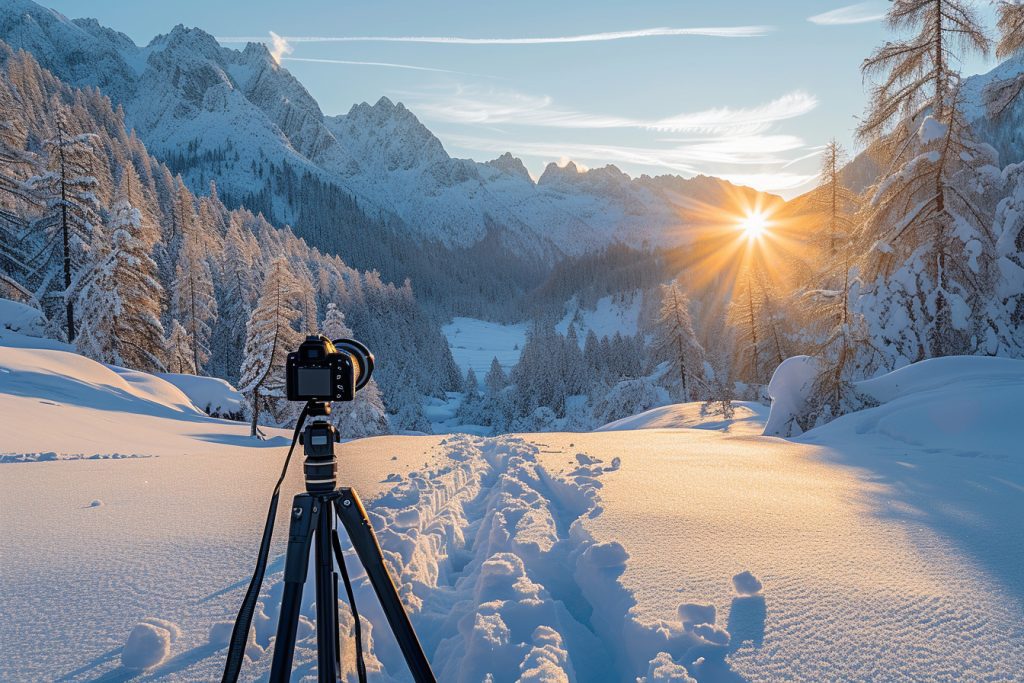Winter photography thrives on the unique quality of light. Shorter days, the sun’s low position in the sky, and the reflective nature of snow combine to produce a soft, diffused light that can add a magical touch to landscapes. Identifying the most favorable light is critical. Early morning and late afternoon, known as the golden hours, can provide warm hues contrasting with the coolness of the snow, while overcast days are perfect for capturing the intricate details of ice and snow without harsh shadows.
Embrace overcast skies
Bright, sunny days might appear ideal for photographers, but overcast conditions should be welcomed. They provide even lighting and reduce the high contrast often found in snowy scenes. Uniformly lit landscapes under a blanket of clouds allow for capturing subtle tones and details.
Maximize the golden hours
During winter, the sun never climbs too high, casting long shadows and creating texture in your photos even at midday. Leveraging the golden hours can result in images with warm sidelight that accentuates shapes and contours within the snow.
Gear preparation

Venturing into the cold with cameras requires due diligence to ensure optimal performance and maintenance of equipment.
Control battery life
Low temperatures are notorious for depleting battery life rapidly. Carrying spare batteries and keeping them close to one’s body helps in preserving their charge.
Preventing lens fog and condensation
Moving from a warm indoor setting to the cold outdoors can cause lenses to fog. Acclimatizing the camera to the chilly weather gradually is a prudent approach.
Filters for the win
Polarizing filters can be instrumental in snowy landscapes. They enhance the blue of the sky, reduce glare, and increase the visibility of clouds. A neutral density filter is also beneficial for controlling exposure in bright snow conditions and facilitating the use of wider apertures or longer shutter speeds.
Composition in a winter wonderland
Captivating compositions in winter photography often result from an understanding of the landscape’s unique elements.
Leading lines and natural frames
Use paths, streams, or tree lines to guide the viewer’s eye through the picture. Branches heavy with snow can also create natural frames around the subject of the image.
Simplicity speaks volumes
A minimalist approach can be powerful. Less cluttered scenes can lead the eye directly to the focal point without distraction.
The rule of thirds and beyond
While the rule of thirds remains a staple in compositional guidance, breaking this rule can sometimes lead to even more fascinating photographs. Symmetry and patterns, especially with the stark contrasts of a winter scene, could call for a centered composition.
Exposure mastery
Achieving the right exposure in winter scenes is often one of the most challenging aspects of snowy photography.
Expose for the snow
Camera meters are easily misled by bright snow, which can result in underexposed images. Compensating by overexposing one or two stops can retain the snow’s true brightness while still capturing detail.
Histograms are helpful
Reviewing a photo’s histogram is more reliable than looking at the image on the camera screen, particularly in bright winter light. It helps in ensuring that highlights are not blown out and details in the shadows are preserved.
Shooting in raw
Shooting in RAW format is beneficial for winter landscapes. It captures a wider dynamic range, providing more flexibility in post-production to adjust exposure and correct for any color shifts caused by snow glare.
Color and white balance
Snow naturally reflects the subtle hues present in the environment and the sky, creating opportunities for nuanced color palettes.
Adjusting white balance
Auto white balance can sometimes render snow as dull or blue-tinted. Adjusting white balance settings manually can help achieve a more accurate representation of the scene’s colors.
Embrace color shifts
Do not always rush to correct the cooler tones. The slight blue cast can often enhance the cold feel of a winter scene, contributing to the mood of the photograph.
Post-Processing tips
Refining winter images in post-production is an essential step to achieving the envisioned results.
Balancing exposure and contrast
Snow scenes may require a delicate balance of exposure and contrast adjustments. Bringing out details without making the image appear flat is key.
Saturation and color grading
Subtly increasing color saturation can bring life to an image, but the trick is not to overdo it. Color grading can also add a personal touch or mood to the images.
Selective sharpening
Applying sharpening selectively ensures that elements such as snowflakes or frost are crisp without introducing unwelcome noise in the skies or other smooth areas.
Timing and patience
Snowy landscapes are ever-changing, and timing is everything. Await those moments when the light breaks through the clouds or when fresh snowfall blankets the scene. Remaining patient, observant, and ready to capture those fleeting moments often distinguishes the extraordinary from the mundane.
Predicting weather changes
Understanding weather patterns and predicting changes can play into the hands of a well-prepared photographer. Often, the moments before a storm clears or right after it ends offer the most dramatic and fresh snow landscapes.
Return to familiar scenes
Revisiting the same location in different weather conditions or times of day can yield a diverse range of images and challenge one’s creative approach to familiar subjects.
Safety and environmental considerations
Braving winter elements not only presents challenges to equipment but also personal safety and environmental responsibility.
Prioritize safety
Dressing in layers, carrying necessary provisions, and being mindful of terrain and weather conditions are paramount.
Leave no trace
While capturing the pristine beauty of winter landscapes, it is vital to practice the principles of Leave No Trace to preserve the natural environment for others to enjoy and photograph.
Engage with the elements
Working with winter’s unpredictable nature requires flexibility. Allow falling snow to add atmosphere to a shot or use ice formations as natural sculptures within a composition. Engaging with the winter elements rather than working against them can lead to unique and compelling imagery.
Through an intricate balance of technical knowledge, creative composition, and an appreciation for the subtle shifts in winter’s ambience, snowy landscape photography can transform the challenging cold into stunning photographic masterpieces. By ensuring thorough preparation and embracing the nuances of winter’s light and landscapes, photographers can craft images that resonate with the tranquility and beauty of the season.









